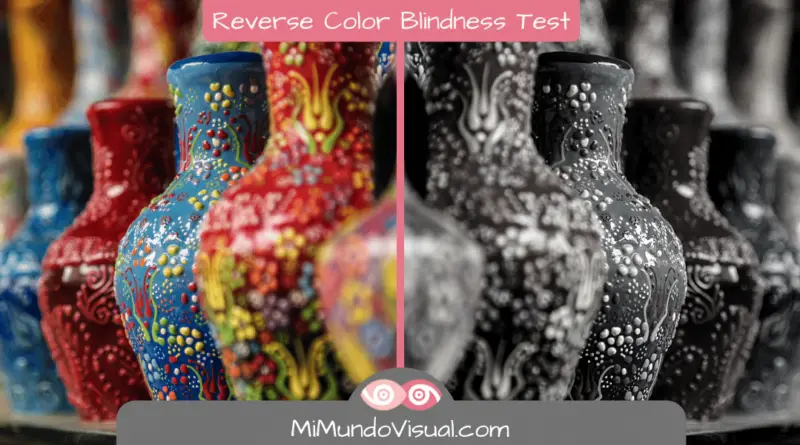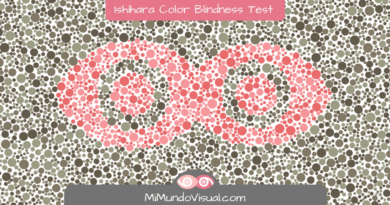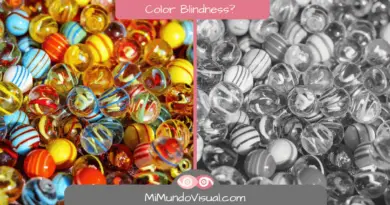Reverse Color Blindness Test
Table Of Contents
The reverse color blindness test – is a test that uses images that only a color-blind person will be able to see correctly.
In other words, a reverse color blindness test is the opposite of the traditional color blindness test, in which we can only see the correct image if we do not suffer from any color deficiency.
In the following article, we want to learn more about the reverse color blindness test, which leads us to other related questions about color blindness, such as:
- What is color blindness?
- What colors do color-blind people see?
- How do people with color blindness see
- What are the consequences of color blindness?
But, let’s start at the beginning: What is the Color Blindness Test?
You might be interested in…
- Color Blindness – Daltonism
- What Is A Stye And Why Do They Appear?
- 7 Questions About Myopia Answered!
- Ametropia?
- What is Computer Vision Syndrome?
- Eye Fatigue – Asthenopia – All You Need To Know!
- 4 Questions About Cataract Surgery
Download our Free Amblyopia Guide
Color blindness test
To detect whether a person is color blind or not, a color blindness test must be performed. The most commonly used test is the Ishihara Test, created in 1917 by the Japanese ophthalmologist Shinobu Ishihara.
Ishihara Color Blindness Test
This color test consists of a series of 38 cards in which there is a circle with colored dots of different sizes inside.
In the central part of the circle are some numbers or symbols, which are also formed by dots of different colors.
A color-blind person will have difficulties seeing these numbers or symbols in the Ishihara Test and may be unable to visualize the number in some cards.
Farnsworth Color Blindness Test
Apart from the Ishihara Test, there are other color blindness tests. One example is the Farnsworth Test, in which the person performing the test has to sort a set of colored cards according to their shade.
Once you have completed the series of palettes, when you turn them over, you can check if the order you have chosen is correct.
In the following video we can see what the Farnsworth Test consists of:
Color Blindness Test With Anomaloscope
The anomaloscope is a device that is also used in the detection of color blindness, although it is not available in many clinics due to its high cost.
With this device, it is possible to detect if there is a color deficiency and its severity utilizing prisms that break down white light.
Ready to take a color blindness test?
Ready to take a color blindness test? In that case, the following link of the Colorite Lens website offers several types of color blindness tests you can take online. They are based on the Ishihara color blindness test and the Farnsworth color blindness test.
Reverse Color Blindness Test
The reverse color blindness test, is a test, in which a person with a color deficiency can see the number or the figure on the slide, and a person with normal trichromatic vision cannot.
In other words, the reverse color blindness test functions opposite to the original test. This way, a person with some color deficiency does not feel so frustrated by being unable to distinguish the inner figure, as with the color blindness test.
In the Ishihara color blindness test, there are 5 different groups of primers, according to The College of Optometrists:
- Group 1: Anyone can read the chart.
- Group 2: It will read differently depending on whether the person is color blind or not.
- Group 3: Only people with normal vision will be able to read it.
- Group 4: Only people with a color deficiency can read it.
- Group 5: It will be read differently, depending on whether the person has a protan (red) or deutan (green) deficiency.
In this case, the cards in group 4 are the slides of the reverse color blindness test, which only the color-blind person can recognize.
Not just any color-blind person, but the anomalous trichromatic deuteranomalous, who has difficulty distinguishing red and green. This is the most common type of dyschromatopsia.
This is possible because color-blind people can distinguish differences in brightness that people with normal trichromatic vision cannot detect. This is known as Reverse color blindness.
For example, deuteranomalous color-blind people are said to be able to recognize camouflage better than non-color-blind people.
They have a greater sensitivity to detect certain color combinations and may be able to visualize shades that people with normal color vision would not be able to distinguish.
If we follow this link from the Neo Frontiers website, we can see 3 examples of images of inverse color blindness.
And in the following article J. Ángel Menéndez, chemist and researcher at the Instituto Nacional del Carbón (INCAR) and expert in color blindness, shows us certain hypotheses (not proven) concerning the satisfactory evolutionary compensations that being color blind could entail, given the large number of color blind people worldwide (8%).
Hypotheses about Reverse Color Blindness
Some hypotheses of inverse color blindness such as the possibility of the existence of women with a fourth type of cone instead of the 3 cones that a person with trichromatic vision has.
In this way, the person would be tetrachromatic and would be able to see a broader range of colors.
However, it is also indicated that this type of inverse color blindness can be difficult to detect, since people who might have it are unaware that other people cannot see the world in the same way they see it.
Another hypothesis presented in Menéndez’s article deals with the emotional influence of colors on people’s ’emotional state.’ Since color-blind people do not perceive colors in the same way as the rest, the effect of colors on them could also be different.
On the other hand, color-blind people might be more cautious than others because they cannot discern colors as easily.
Finally, it deals with a possible hypothesis of perceptual advantage in which it is questioned whether color-blind people could have the ability to have a faster vision by having fewer colors to process, similar to what happens with some insects, such as the bumblebee, which can switch from color vision to achromatic vision to be able to process images faster.
However, now that we know what color blindness is, how do people with color blindness see, or what colors do color blind people see?
What Is Color Blindness?
Color blindness is an alteration in the ability to distinguish colors, mostly of hereditary origin.
Although men are the most affected by this color dysfunction, color blindness is transmitted genetically through the X chromosome, usually from mother to son (male). For a female to be color blind, both of her X chromosomes must carry the gene.
A color-blind person cannot see colors the way most people can.
Color blindness is a color deficiency and usually involves an inability to differentiate red and green colors and, less frequently, blue and yellow tones. Although the degree of color blindness varies greatly.
It ranges from the inability to appreciate any color at all (known as achromatopsia or color blindness) to a small and subtle difficulty in distinguishing shades of red, green, and sometimes blue.
How Do People With Color Blindness See?
To better understand how people with color blindness see, we must first know that we have sensory cells in the retina of our eyes, known as photoreceptors.
Photoreceptors react in response to light, and there are two types: rods and cones.
Thanks to the rods, we can appreciate black, white, and shades of gray, and they are activated in the dark.
On the other hand, cones are the light-sensitive photoreceptors of the retina and are activated during the day or in illuminated environments and allow us to see colors.
We have three types of cones: one type of cone is sensitive to red light, another to green light, and another to blue light.
The combination of these three colors allows us to see the world in a wide range of colors.
Depending on the incorrect functioning or lack of one or all three types of cones, we will have one type of color blindness or another.
That is to say, the vision deficiency may be due to the following:
- The cones do not exist (or some of them), known as anopia.
- The cones (or some of them) do not function properly, which is an anomaly.
Therefore, color blindness can be monochromatic, dichromatic, or anomalous trichromatic.
The ability to have normal color vision is known as trichromatism (since three primary colors can be perceived).
The opposite of trichromatic vision is achromatic vision. It occurs when a person does not have any of the 3 types of cones. Therefore, they will not be able to appreciate any color.
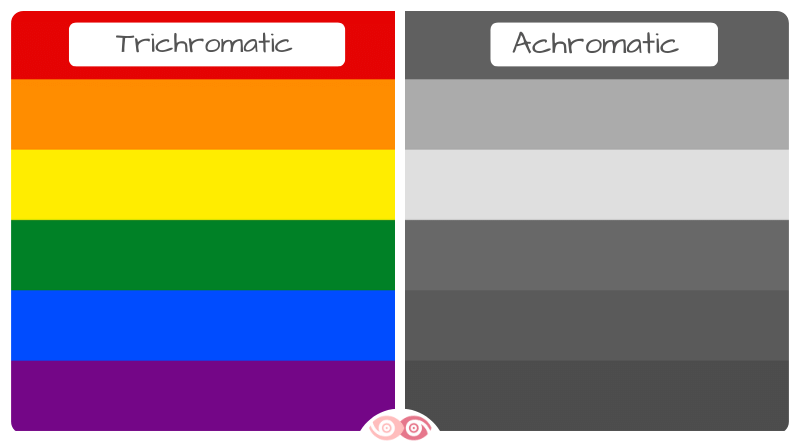
Abnormal trichromatism, on the other hand, refers to a person who has the three types of cones but has functional defects that make them confuse colors and perceive the shades of colors altered. This is the most common case among color-blind people.
In the Handbook of Cognitive Neuroscience (2014), Redolar states that ‘Each of the three types of cones has a different sensitivity depending on the wavelength to which they are tuned’ (p:275), following experiments by Young and von Helmholtz of the trichromatic theory:
C cones (encode the color blue) make up 5-10% of all cones and have maximum sensitivity to short waves.
M cones (green color coding) make up about 40% of the total number of cones and have maximum sensitivity to medium waves.
L cones (encoding the color red) make up 50% of the cones and are sensitive to long waves.
Therefore, the three main types of visual color deficiency are: protan defect (red color blindness), deutan defect (green color blindness), and tritan defect (blue color blindness). These terms come from Greek and are translated as first, second, and third.
What Colors Do Color Blind People See?
As we discussed, there are different types of color blindness depending on the deficit in the cones (achromatic, monochromatic, dichromatic, or anomalous trichromatic).
Let’s see which colors color-blind people see:
Anomalous Trichromatism
Suppose the color-blind person has an anomalous trichromatic deficiency. In that case, the retina has the same three types of cones as a person who can see colors normally.
However, one of these cones is out of focus, causing the person to confuse the colors and perceive the shades of the colors altered.
This is the most common form of color blindness. Depending on the functional alteration, it can be a protanomaly, deuteranomaly, or tritanomaly.
Reminder: from the Greek Protan (first, red blindness), deutan (second, green), and Tritan (third, blue).
Red-green color blindness combines protan (red) and deudan (green) defects. It is the most common form of color deficiency and can be a protanomaly or deuteranomaly.
Blue-yellow color blindness is rare, and the color-blind person has a reduced sensitivity to the color blue (Tritan), so it can confuse blue from green and red from purple, known as tritanomaly.
Dichromatism
In the case of dichromatism, the color-blind person has two types of cones in the retina instead of the three necessary for normal color vision.
We have 3 types of dichromatism:
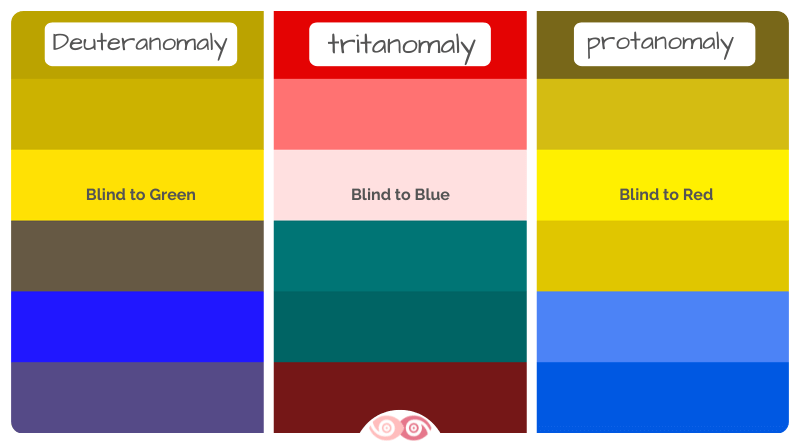
Types of color blindness
- Protanopia: people who can see colors from the combination of green and blue, as they do not have L (red) photoreceptors.
- Deuteranopia: people who can see colors from the combination of blue and red. They do not have M (green) photoreceptors.
- Tritanopia: this is one of the least common disabilities and involves people who do not have C (blue) photoreceptors.
Therefore, depending on the type of color blindness and color deficiency :
- Protanopia, red blindness; Protanomaly, red weakness.
- Deuteranopia, green blindness; Deuteranomaly, green weakness.
- Tritanopia, blue blindness; Tritanomaly, blue weakness.
Monochromatism
A color-blind person with monochromatism has only one of the three cone pigments in their retina. The vision of light and color will be perceived in one dimension.
In the following link, J. Ángel Menéndez presents a translation of John Dalton’s 1794 paper: ‘Extraordinary facts relating to color vision, by John Dalton.’
From the original English version: Extraordinary facts relating to the vision of colors in which Dalton explains his relationship with colors. This was the first time that color deficiency was discussed, thus giving color blindness its name.
What Are The Consequences Of Color Blindness?
The most common type of color blindness is deuteranope, an optical defect in distinguishing between the colors red and green.
And sometimes, this defect is so subtle that the color-blind person is not even aware that he or she suffers from this color deficiency and believes that everyone else sees the world in the same way.
Although in children, for example, it can cause learning problems in subjects where colors are used as a teaching aid, as indicated by the psychologist Trinidad Aparicio at PulevaSalud.
However, they often do not realize it is a color anomaly until a color blindness test is performed at an ophthalmologist’s office.
As Mrs. Aparicio points out, it is important to present the situation to the color-blind child as a ‘characteristic’ and not as a problem so that they do not feel different. It also helps to point out that this does not keep them from leading a normal life.
Color blind people can lead a normal life in almost all aspects. However, they may have difficulties such as combining colors when dressing, differentiating if a food is fresh, painting, or taking photographs.
However, this fact should not be an impediment either. It is speculated that great painters such as Van Gogh were color blind.
Color blind people may be prevented from exercising some professions, such as airline pilot or marine navigator, air traffic controller, soccer referee, etc., in which it is necessary to distinguish colors clearly when passing a medical examination.
In the following video, the journalist Enric Botella shows us how color-blind people see and what it is like to live without being able to perceive colors well:
And we would like to end this article with Miguel Neiva:
In recent years the Portuguese graphic designer Miguel Neiva has created an ADD color code, which allows an easier life for those people with difficulties in distinguishing colors.
It is a ‘symbol’ language system made up of 3 shapes, and each of these 3 shapes is identified with one of the 3 primary colors.
That is, yellow is represented by a diagonal line, red by a triangle, and blue by an inverted triangle.
The combination of these 3 symbols can identify any color, and by adding black and white, light or dark shades can be identified.
The ADD color code is already used in signage in some hospitals in Portugal, on clothing labels, on medicines, or on colored pencil boxes, to name a few examples.
The language created by Neiva could allow the total integration of color-blind people in the society in which we live, and it could be the biggest advance related to color blindness.
If you want to know more about ColorADD: Interview with Miguel Neiva – ColorADD and Color Blindness.

